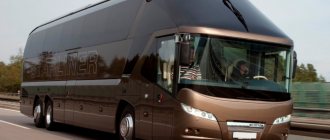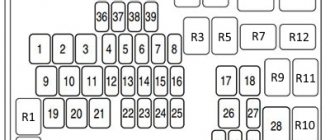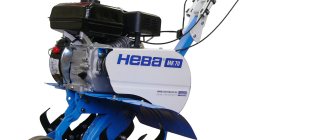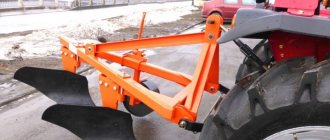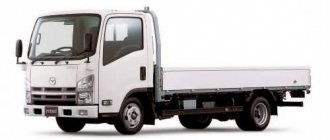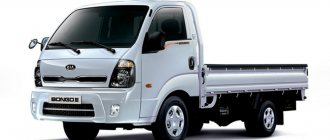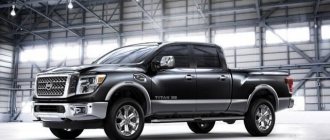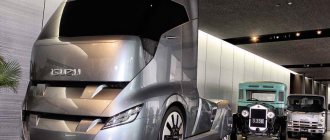The pride of the Japanese automaker was first presented to the world in 1966. At the beginning of the second half of the last century, the capabilities of the first Mazda Bongo series were somewhat modest. This is when compared with modern foreign cargo trucks and minivans. And at the time of the start of production, the cars were positioned as a very worthy development, not inferior in basic technical characteristics to competitive analogues.
The growing popularity of the Mazda Bongo was confirmed by the release of subsequent generations of models and strong consumer demand. Each truck and minivan met the established technical parameters, universal design solutions, and thanks to successful developments, the vehicles were used in industrial, business, and agricultural areas. Mazda Bongo lines were actively purchased by private farmers, heads of companies, factories, and individual citizens.
According to technical characteristics
Serial production of Mazda Bongo began with rear-wheel drive cars. They were equipped with low-power gasoline internal combustion engines F800. The working volume was 0.782 liters. With the design of new series, the concept of equipping with engines was revised. The previous units were replaced with more advanced F1000 power units with a power of 48 l/s. Around that time, all-wheel drive modifications of popular four-door car models began to roll off the assembly lines of the Japanese auto giant.
By the beginning of the seventh decade, designers had developed new light-duty pickups and trucks, but the vehicles had a number of shortcomings - one of which was insufficient resistance to rust. This factor significantly influenced the period of operation, when after 5 years of intensive use of the Mazda Bongo, the body was exposed to active corrosion processes. This defect and other shortcomings forced the Japanese automaker in the late 70s to begin production of second-generation cars with engines of 1.3, 1.4, 1.6 liters.
In the early eighties, a new class of Bongo cars began to roll off Mazda's assembly lines. Distinctive characteristics:
- attractive body design;
- improved technical parameters;
- equipped with diesel engines.
The diesel engine lines differed from each other. The difference was determined by the volume of liters: 2.0 and 2.2. Along with improved models of trucks and third-generation minivans, long-wheelbase lines of cars were put into production and subsequently produced for sixteen years. Also, the automaker's engineers developed modifications of vehicles that operate using an electric drive, automatic transmission and other innovations.
The fourth generation of Mazda Bongo: trucks, minivans received a beautiful design, an anti-lock wheel system and safety improvements. With the start of production of updated modifications in 1999, changes were systematically made to the design of the machines - equipment:
- gasoline, diesel power units;
- long, short bases;
- fuel system with direct injection;
- improved electrical equipment;
- electric windows;
- central locking
Some of the latest upgrades are the installation of economical engines, an automatic five-speed gearbox, keyless entry, and class designation with new abbreviations SLP2V, SLP2M.
Reviews of Mazda truck models / Mazda
Mazda (Mazda Motor Corporation, 1927–1984 Toyo Kogyo Company), a Japanese automobile company specializing in the production of trucks, buses, minibuses and cars. Part of the Sumitomo financial and industrial group. The headquarters is located in Hiroshima. Founded in 1920 as a cork recycling company. In 1927, the company was renamed Toyo Koguo Co Ltd.
1931 Start of production of three-wheeled cars. The first vehicles made by this company were three-wheeled cargo scooters, the demand for which was great at that time - within 25 years, 200 thousand of them were produced. A large number of these cargo scooters were produced for the Japanese army during World War II. The company's enterprises survived even during the atomic bombing of Hiroshima.
After the war, the company began producing trucks. The first passenger cars appeared only in 1960. It was the R360 Coupe, the first two-door passenger car, powered by a 356 cc 2-cylinder engine. It was not particularly sophisticated, but it was inexpensive and convenient.
In 1962, the introduction of the Mazda Corol 600, the first four-door passenger car
In 1964, the 1st generation Mazda Familia (800/1000) was released. Since 1964, passenger cars began to be exported to the United States.
In 1965, the Mazda Proceed pickup truck (B-series 1500) was released.
1967 - the beginning of full-scale exports to the European market - the introduction of the Mazda Cosmo Sports (110 S), the first Mazda car with a Wankel rotary engine (supplying it abroad since 1971). In the same year, Mazda reaches an agreement in technical cooperation with Kia Motors Corp.
In 1968, the debut of the Mazda Familia Rotary Coupe (R100)
Since 1970, export to the USA began. In the same year, the Mazda Capella (RX-2) was introduced.
1971 - Mazda Savanna (RX-3) introduced
1972 - Mazda Luce (RX-4) introduced. In the same year, the number of cars produced reaches 5 million units.
In 1977, the Mazda Familia (Original GLC/323) was released, as well as the introduction of the Mazda Capella (626).
In 1978, the Mazda Savanna RX-7 model appeared
In 1979, Mazda and Ford Motor Company entered into a single union. At the same time, Ford Motor acquired a 25% stake in Mazda.
In 1980 - introduction of the FWD Mazda Familia 4 WD. In the same year, the Mazda Familia (GLC/323) was named “Japanese Car of the Year 1980-81”.
By 1981, most of the company's cars were equipped with Wankel engines; by this time, success in developing the American market became so great that the American branch of the company, Mazda North America, Inc., was opened. With the increase in the market for consumers of expensive cars, the range of Mazda products is constantly expanding, sports cars, upper middle class cars, etc. are appearing. Mazda RX-7 is a clear example of the achievements of the Japanese company: the original body design combines increased body rigidity with a simultaneous reduction in its weight .
In 1981, the Mazda Cosmo/Luce (929) was introduced.
1982 introduction of the Mazda Capella 4 WD, in the same year the Mazda Capella 4WD (626) was named "Japanese Car of the Year 1982-83".
In 1983, the Mazda Capella (626) was named "Import Car of the Year" by Motor Trend magazine (USA). At the same time, Mazda entered Kia Motors with 8% capital.
In 1984, the company was renamed Mazda Motor Corporation.
1985 - presentation of the new Mazda Luce (929) in Japan.
In 1987, the number of cars reached 20 million in Japan. The new Mazda Savanna RX-7 is coming out. The company begins automobile production at the new American plant, Mazda Motor Manufacturer, which is located in Michigan. In the same year, the introduction of the new Ford Festiva (Mazda 121), manufactured by Mazda.
In 1988, the Mazda MPV was released in the USA.
In 1990, Eunos Cosmo (equipped with a car navigation system) appeared in Japan, as well as Autozam Revue (121).
In 1992, the new Mazda 626 received the title “Car of the Year”.
In 1998, the new Mazda 323 was introduced, and Mazda Demio sales began in Europe.
In 2000, the Mazda MX-5 Roadster, which this year received a completely new body design, is listed in the Guinness Book of Records as the world's most popular sports roadster. The new Mazda Tribut SUV is coming out. At the Detroit Auto Show, the RX-Evolve concept, the predecessor of the currently produced RX-8 model, was shown.
2001 - The new Atenza and a preliminary version of the RX-8 with a Renesis rotary engine are demonstrated at the Tokyo Motor Show. Roadster receives the main prize "Auto Color Award 2001". Many Mazda models this year received additional, “sports” modifications.
In 2002, the company opened its own nursery and released a new modification of the MPV model - Sports F, developed by women.
Currently, Mazda produces a wide range of cars - from small cars to luxury sedans, with strong growth in the SUV and high-capacity car sectors. In the range of sports models, the world famous RX-7 has been replaced by the RX-8. The company works closely with Ford in matters of development and sales strategy. Mazda assembly plants in 21 countries allow it to export its cars to 120 countries around the world.
Website: www.mazda.com
Representative office in Russia: www.mazda.ru
Cost of car maintenance and operation per year
Mazda Bongo cars of the first lines are rarely found on modern roads. Mostly you can see trucks or minivans of the third and fourth generation. Despite the high quality of assembly, technical characteristics, maintenance and operation require financial costs. And the older the vehicle, the greater the investment required. If we give the example of an “Asian loaf” with an automatic transmission, we can draw certain conclusions regarding the upcoming costs.
In general, all Mazda Bongo models are very ergonomic and meet the expected conditions.
- Reasonable price.
- Good passenger and cargo capacity.
- Incredibly practical.
- Required versatility.
But, since even the fourth generation of trucks and minibuses is the last, you can only purchase a used vehicle, second-hand. Therefore, you need to be prepared for large and small financial expenses.
First of all, you should not count on economical fuel consumption. In fact, every car from any Mazda Bongo model range is not distinguished by modest fuel consumption (10-12 liters per 100 km), especially if the vehicle mileage is 400,000 kilometers or more without replacing the engine, replaceable components: bushings, oil seals, gaskets, filters, discs. Consumption is also affected by the lack of necessary maintenance, during which the reasons for the increased consumption of fuels and lubricants are identified.
general information
It is difficult to say about the specific cost of maintenance and operation. We can only say with confidence that the price of fuels and lubricants has increased: gasoline, oil, replacement of large and small parts in the segment of repair work: engine, chassis, transmission, electrical equipment due to external conditions and inflation, above all.
Another important factor influencing the cost of maintenance is the use of cars. A good owner who treats the Mazda Bongo with thrift will have a car that will last a long time. For example, models with automatic transmission are not intended for setting records, conducting test drives, sudden starts and braking. With systematic technical regulations and gentle operating conditions, the “Asian loaf”: a truck or minivan will work for several decades.
Performance indicators
Each Mazda Bongo model is endowed with unique properties that depend on the design features, the set of capabilities of the installed components, and parts that ultimately form:
- total vehicle weight;
- body modification;
- speed;
- power;
- permeability;
- fuel consumption;
- acceleration;
- load capacity;
- passenger capacity.
For example, the Bongo series 3 and 4 have incredibly high variability in such characteristics.
From 1990 to 1994, the “Japanese” - Bongo III and Bongo IV (1999-2010) were manufactured (depending on the model):
- with rear or all-wheel drive;
- body type;
- number of places;
- doors;
- length, width, height;
- wheelbase;
- clearance;
- front, rear tracks.
They were equipped with diesel and gasoline internal combustion engines with different numbers of horsepower, torque, revolutions, power systems, power, and transmission parameters. They were distinguished by the presence of an automatic or manual gearbox with 4 or 5 gears, fuel tank capacity, steering (turn (diameter in meters)).
Third generation (1983 - 1999)
Mazda Bongo 3rd generation appeared in 1983. The appearance of the car has changed, and the engine range has also expanded: in addition to three petrol modifications, Mazda Bongo has appeared with a diesel engine. The diesel version with a 2.0-liter engine was designated Mazda Bongo Diesel, and the one with a 2.2-liter engine was designated Mazda Bongo R2.
The high-torque diesel engine provided the Mazda Bongo trucks with excellent throttle response and efficiency.
Three months after the premiere of the third generation Bongo, Mazda released a long-wheelbase modification of the Brownie (Mazda Bongo Brawny). The overall dimensions of the new product exceeded the dimensions of conventional Bongos in all main indicators (wheelbase, length, width, height and weight), in addition, the number of interior transformation options has significantly increased.
The Mazda Bongo Brawny minivan features an extended wheelbase and a large rear overhang
Since 1984, in addition to Ford, which produced a similar minivan under the names Spectron (passenger version), Econovan (cargo model) and Econovan Maxi (long-wheelbase model), Nissan (Nissan Vanette minivan) also began producing an analogue of the Mazda Bongo.
More on the topic: Volvo 770 tractor unit – motorhome
The third generation of Bongo vans and trucks was produced for 16 years. During this period, the model line expanded to include an all-wheel drive version of the Mazda Bongo 4wd, a modification with an automatic transmission, and a model with an electric motor, the Bongo EV.
All-wheel drive Mazda Bongo 4WD
Technical characteristics of Mazda Bongo:
- Body type - minivan
- Number of doors - 4
- Engine - petrol FE, or diesel RF
- Dimensions (length x width x height) - 4230 x 1630 x 1970 mm
- Wheelbase - 2220 mm
- Track (front, rear) - 1415, 1370 mm
- Fuel tank volume - 48 l
Engine
Over time, in parallel with the improvement of car models, the power plants in the Mazda Bongo underwent changes, were modernized or fundamentally new solutions were installed. Cars of the first lines, production of which began in 1966, were equipped with two types of low-power internal combustion engines F 800 F 1000. Four-stroke units with a volume of 782.987 cm³ and water cooling located at the rear, had low power with low kW consumption.
In general, depending on the Mazda Bongo classification, a different approach was used to installing internal combustion engines. In different models they were placed: in front, behind or in the middle. In the second generation of Japanese cars, produced between 1977 and 1980, internal combustion engines were used in relation to the following series:
- 1272 cm³, TC 60 hp (44kW) / 77 hp (57 kW), JIS (Japan) – BA 2T8;
- 1586 cm³, NA 80 hp (59 kW) / 82 hp (60 kW), JIS (Japan) – BA2N9;
- 1415 cm³, UC 70 hp (52 kW).
Trucks and minibuses were marked regarding the installed power units and their types. For example, cars with indexes E 1300, E1400, E1600 were exported from Japan.
The release of a fundamentally new Mazda Bongo line was marked by the successful development and implementation of internal combustion engines for third-generation cars. Vehicles of various models were equipped with engines (petrol (B), diesel (D)) of improved design (all-wheel drive PP) (rear-wheel drive ZP)):
- Braw 2.0 AT (82 hp) 4WD (B) (PP);
- Braw 2.0 AT (82 hp) (B) (GP);
- Braw 2.0 MT (82 hp) 4WD (B) (PP);
- Braw 2.0 MT (82 hp) (B) (GP);
- Braw 2.0d AT (71 hp) 4 WD (D) (PP);
- Braw 2.0d AT (71 hp) (D) (GP);
- Braw 2.0d MT (71 hp) 4 WD (D) (PP);
- Braw 2.0d MT (71 hp) (D) (GP);
- 0 AT (82 hp) (B) (ZP);
- 0 AT (82 hp) 4WD (B) (PP);
- 0 MT (82 hp) (B) (ZP);
- 0 MT (82 hp) 4WD (B) (PP);
- 0d AT (71 hp) (D) (GP);
- 0d AT (71 hp) 4WD (D) (PP);
- 0d MT (71 hp) (D) (GP);
- 0d MT (71 hp) 4WD (D) (PP).
All of them were endowed with various technical properties: torque, horsepower (...at rpm).
The fourth generation of Mazda Bongo cars received new internal combustion power plants: gasoline (B), diesel (D), all-wheel drive (AP), rear-wheel drive (RW).
- 8 AT (102 hp) (B) (ZP);
- 8 AT (102 hp) 4WD (B) (PP);
- 8 AT (95 hp) (B) (ZP);
- 8 AT (95 hp) 4WD (B) (PP);
- 8 MT (102 hp) (B) (ZP);
- 8 MT (102 hp) 4WD (B) (PP);
- 8 MT (95 hp) (B) (ZP);
- 8 MT (95 hp) 4WD (B) (PP);
- 0d AT (86 hp) (D) (GP);
- 0d AT (86 hp) 4WD (D) (PP);
- 0d MT (86 hp) (D) (GP);
- 0d MT (86 hp) 4WD (D) (PP).
The petrol engines used were 2.0L FE SOHC I4, 2.5L RF-V V6, 2.5L J5, and 2.5L WL-T turbodiesels.
CONTENT
- 1 Historical trucks
- 2 First generation (1961–1965)
- 3 Second generation (1965–1977) 3.1 Rotary pick-up
- 3.2 Ford Courier
- 4.1 Ford Courier 4.1.1 Electric options
- 5.1 North America 5.1.1 Models
Transmission
Regarding the specifics of Mazda Bongo cars, different types of units and transmission mechanisms, called transmissions, were installed on vehicles. Different gearboxes are endowed with positive advantages and negative points, which also apply to Mazda Bongo cars.
- Automatic transmission. Comfortable conditions while driving a vehicle. But the cost of an automatic transmission is high.
- Manual transmission. Main advantages: durability, low price. However, in a densely populated metropolis with an endless number of traffic jams, it is inferior to the automatic machine in terms of versatility.
Mazda Bongo trucks produced since the beginning of 1999, SK, were equipped with automatic and manual gearboxes.
It makes sense to list several configuration options for 4th generation trucks.
- 8 GL wooden deck wide low 4WD manual transmission;
- 8 DX wooden deck wide low 4WD manual transmission;
- 0 GL long wooden deck double tire diesel turbo manual transmission;
- 0 GL wide low long diesel turbo manual transmission;
- 8 DX Single Wide Low Long 4WD automatic transmission;
- 8 GL double tire 4WD automatic transmission;
- 0 DX long double tire diesel turbo 4WD automatic transmission;
- 0 GL double tire diesel turbo automatic transmission.
Each transmission option used had advantages and disadvantages.
Gearboxes used in Japanese minivans since 1999.
- 8 DX low floor 4WD (2 seat) manual transmission;
- 8 DX Low Floor High Roof 4WD (4 door 5 seat) Manual transmission;
- 0 GL low floor diesel turbo 4WD (4 door) manual transmission;
- 2 CD wide low high roof diesel (5 door) manual transmission;
- 8 GL low floor high roof 4WD (4 door) automatic transmission;
- 8 GL wide low (4 door) automatic transmission;
- 0 DX low floor diesel turbo (5 door) automatic transmission;
- 2 GL wide low high roof diesel (4 door) Automatic transmission.
On cars of the third line, produced since the beginning of 1993, after the 2nd restyling, the following were installed: 2.0DT RV-S (manual transmission), 2.0DT Limited sun roof (automatic transmission) and others.
Fourth generation Mazda Bongo (1999 - 2012)
In 1999, the production of Mazda Bongo minivans and trucks of the fourth, and apparently the last generation began. In 2012, company executives announced that Mazda would cease production of commercial vehicles and focus on developing fuel-efficient vehicles. The fourth generation of Mazda Bongo includes Bongo Van vans, Brawny Van minibuses and Bongo Truck mini-trucks with a carrying capacity of up to 1000 kg, as well as refrigerators built on the chassis of a Mazda Bongo truck. When creating these models, special attention was paid to safety requirements: the cars are equipped with airbags and ABS.
Mazda Bongo Van fourth generation
Mazda Bongo Truck fourth generation
A small refrigerator based on the Mazda Bongo Truck
Dimensions in mm
It is known that the dimensions of a car play a key role in the driving process. A large vehicle is more difficult to drive. The body dimensions of Mazda Bongo cars are structured in millimeters according to three components: width, length, height. It is not difficult to guess how the two main measurements are made - from fundamentally distant opposite parts. The height is determined starting from the road and ending with the top point of the roof.
As examples, we can cite several parameters of cars of different models. Minibus Mazda Bongo Friendly 1995: configurations, dimensions:
- 0 RS-V, 4585 x 1690 x 1960;
- 5DT RF-V, 4585 x 1690 x 1960;
- 5DT RF-V sun roof, 4585 x 1690 x 1960;
- 5DT RS-V auto free top, 4585 x 1690 x 2090;
- 5DT RF-V auto free top Hyper slide seat, 4585 x 1690 x 2090.
Mazda Bongo Friendly models produced since 1999 (restyling).
- 0 City Runner II, 4620 x 1690 x 1960;
- 0 City Runner III, 4620 x 1690 x 1960;
- 5 RF-V SE sun roof, 4620 x 1690 x 1960;
- 5DT RF-V auto free top, 4620 x 1690 x 2090;
- 5 City Runner auto free top diesel turbo, 4620 x 1690 x 2090.
Mazda Bongo Friendee (2nd restyling) 2001
- 0 RS-V, 4620 x 1690 x 1960;
- 5 RF-S, 4620 x 1690 x 1960;
- 0 City Runner IV, 4655 x 1690 x 1960;
- 5 City Runner NAVI edition auto free top, 4655 x 1690 x 2090;
- 5 RF-S aero auto free top diesel turbo 4WD, 4655 x 1690 x 2090.
A characteristic feature is a slight change in size relative to the nodes.
Mazda Bongo Friendee (1995 - 2005)
In 1995, the Mazda Bongo Friendee minivan appeared, the same model was produced under the name Mazda Acces and Ford Freda. The car was mainly equipped with a 2.5-liter turbodiesel engine with an automatic transmission, although small series with 2.5-liter gasoline V6, as well as modifications with manual transmission, were also produced for the Japanese domestic market. An all-wheel drive transmission with a viscous coupling was only available in combination with a diesel engine. and gasoline modifications had only rear-wheel drive.
All-wheel drive version of the Mazda Bongo Friendee minivan
Specifications Mazda Bongo Friendee
- Body type - minivan
- Number of doors - 4
- Engine - petrol 5J-DE, or diesel WL-T
- Dimensions (length x width x height) - 4585 x 1690 x 1960 mm
- Wheelbase - 2920 mm
- Fuel tank volume - 65 l
Technical data of Mazda Bongo Friendly engines
5J-DE:
- Engine type - petrol
- Volume - 2494 cubic meters. cm.
- Location and number of cylinders - V6
- Gas distribution mechanism - DOHC
- Power - 160 hp at 6000 rpm
- Torque - 211 Nm at 3500 rpm
More on the topic: Freightliner FLC120: American-style truck tractor
WL-T:
- Engine type - turbocharged diesel
- Volume - 2499 cubic meters. cm.
- Arrangement of cylinders - in a row
- Power system - Common rail
- Power - 120 hp at 3500 rpm
- Torque - 310 Nm at 2000 rpm
Since 1999, the Mazda Bongo Friendly has been equipped with climate control and electronic blinds as standard. In addition, minivans were produced equipped with a lifting roof, into which a two-person tent was built, and the 6-seater Camper modification was equipped with a shower, refrigerator and kitchen equipment built-in from the factory.
The roof of the Mazda Bongo Friendee is equipped with an electric drive, and there is a large hatch for access to the tent
There are a huge variety of options for transforming Friendly's salon:
Thanks to this configuration, the minivan became very popular among tourists, and entire clubs of Mazda Bongo Friendly fans appeared. On the websites of such clubs, registered users exchange information for beginners on servicing and repairing their cars.
In addition, you can find messages discussing tuning options for Mazda Bongo Friendly . There are also very unusual tuning options:
Tuning Mazda Bongo Friendee in the style of BMW cars
In addition to the modified radiator grille, this Mazda Bongo Friendee received tuned bumpers, arches and beautiful alloy wheels.
The most active users often create personal websites on which they not only post photos and descriptions of their Mazda Bongo Friendly, but also give advice on operation and troubleshooting. Reviews from Mazda Bongo Friendly owners found on websites most often note the high reliability of the cars, as well as their good cross-country ability (especially all-wheel drive versions).
Volume and mass
Mazda Bongo car lines - classifications, models had different engine design parameters. The volumes of power plants laid down by the design engineers depended on many other factors of the internal combustion engine. Thus, in third-generation Mazda Bongo vehicles, regardless of the specifics of the fuel used, this value of the required unit remained unchanged - 1998 cm³.
In the IV generation Mazda Bongo cars, the volume was characterized by other indicators - 1798 cm³ for gasoline internal combustion engines (all-wheel drive, rear-wheel drive models) and 1998 cm³ for diesel engines (rear-wheel drive, all-wheel drive). 5j-de units operating on gasoline fuel with an engine capacity of 2,492 cubic centimeters were used for the Friendly minivan lines. The arrangement of 6 cylinders is V-shaped. The weight of vehicles, regardless of design features, varied, from one and a half tons to two.
Suspension and brakes
A number of components play a key role in the braking process of any vehicle, and different Mazda Bongo models are no exception. In the production of minivans (all-wheel drive, rear-wheel drive) from 1990 to 2010, disc (rear brakes) and ventilated disc (front) were used. The Mazda Bongo Friendee lines were equipped with rear and front suspensions with independent springs.
Third generation Mazda Bongo cars were equipped with rear disc brake systems. On the Mazda Brawny series of cars, brake modules were installed at the rear (drum/drive). The suspension system was front and the brake spring was of torsion type. The rear suspension is semi-axle, axle-type leaf spring.
First generation (1966-1975)
Mazda introduced the first Bongo minivan in mid-1966. The rear-wheel drive car was initially equipped with a 782 cc water-cooled four-stroke F800 engine. cm. In 1968, a version with a one-liter F1000 engine appeared, and then an all-wheel drive modification called Mazda Bongo 4wd. Versions with a cargo body and a pickup truck were added to the minivan.
A distinctive feature of the body of the new model was the low and level floor - the loading height was 460 mm. The first generation cars were produced for 10 years, but due to the fact that the body parts for the Mazda Bongo had low corrosion resistance, there were very few copies left in good condition. Fortunately, many photographs and advertising brochures have survived, allowing you to see what the first Mazda Bongo looked like:
Minivans Mazda Bongo F800 and F1000
Mazda Bongo Truck
Weaknesses and typical problems
Every foreign car has vulnerabilities, and modern motorists try to gradually correct defects or turn a blind eye to minor design omissions. There are few errors in the Mazda Bongo lines, but miscalculations still occur. They are identified during the operation stage and relate to the body, engine, and automatic transmission. There are many issues related to comfort. Therefore, experienced car enthusiasts who are aware of most of the shortcomings of the “Japanese loaf” are faced with a difficult choice of which car, the Honda Stepwagon or the Mazda Bongo Friendly, is better.
The most typical problems that drivers-owners of different models have encountered can be identified in a list.
- Insufficient resistance of the metal to corrosion processes.
- Low-power engine.
- The chassis is “weak”.
- Inconvenient location of the radiator.
- Increased rigidity.
- Difficulties with spare parts for main components.
- High fuel consumption, especially in older models.
- Small ground clearance.
- Poor interior heating.
- Periodic problems with automatic transmission.
- Vibration and noise.
To the above disadvantages we can add the specifics of the development - rear-wheel drive cars, an unfinished cooling system for the power plant.
Advantages and Benefits
Along with its shortcomings, Mazda Bongo has excellent advantages, and for most motorists they cover a number of insignificant design omissions.
- Good ergonomics and cross-country ability.
- Excellent capacity for a limited number of passengers
- Load capacity.
- Economical fuel consumption of 10-12 liters per 100 km.
- Maneuverability.
- Reliability.
- Cheap maintenance.
- Four-wheel drive.
- Starts quickly in frosty weather.
- Sturdy suspension.
- Small turning radius.
You can add one more plus - the relatively low cost of the vehicle.
The car lines are perfectly suited for driving in the city and outside the city. They are intensively used by farmers, private owners, small construction companies, firms, and government agencies. Mazda Bongo minivans are suitable as a family car in all respects.
Comparison of equipment
Japanese vehicles can be classified according to the main components used.
- Engine.
- Drive.
- Speed boxes.
- Transmissions.
- Tormozov.
Each line of Mazda Bongo, from generation to generation, was equipped with improved internal combustion engines, automatic transmissions and other systems.
A small comparison regarding the components used can be expressed in a list. Generations of vehicles.
- First. High lifting capacity thanks to low-mounted gearbox.
- Second. Reduced dimensions of brake discs, creating a flat, wide bottom in the car.
- Third. Equipping devices with 2 and 2.2 liter diesel engines. Equipped with a long wheelbase (Mazda Bongo Brownie).
- Fourth. Increased comfort for everyone in the car due to climate control and electronic blinds. It is now possible to open the roof with a pre-installed two-person tent. Added: external lighting, central locking and other innovations.
Along with the above achievements, modified or new internal combustion engines were installed on cars: gasoline, diesel.
Second generation (1977 - 1983)
The second generation Mazda Bongo appeared in 1977. Thanks to the reduced size of Mazda Bongo wheels, it became possible to reduce the volume of the wheel arches and make the interior floor even wider. Thanks to the low and wide interior floor, as well as a clever advertising campaign, Mazda Bongo trucks became the mainstay of sales for Mazda dealers in Japan.
An analogue of the Mazda Bongo called Econovan was sold by Ford, at the same time Mazda exported its cars with the E1300, E1400 and E1600 markings, indicating engine size.
1977 Mazda Bongo minivan
Mazda Bongo Track trucks quickly gained popularity due to their low loading height.
Owner reviews of Bongo III
Certain conclusions about the characteristics of the model can be drawn based on brief reviews.
- A good workhorse, suitable for trips out of town, to the village with the whole family.
- Reliable engine, economical consumption, transportation of goods up to 1 ton.
- Light steering wheel, soft grip, excellent capacity thanks to the reclining backrest.
- It's comfortable to drive in winter. It warms up quickly in the cold, and there is a powerful heater in the cabin.
- It transported it north across all of Russia, and then also operated it as a cargo truck. Transported boards, bricks, sand. Great car.
In general, the cars are positioned on the positive side.
Owner reviews of Vanette IV
“A cheap Ivanovich turned up.” The car is just super. Spare parts are inexpensive, and you can carry your family and cargo. An unpretentious car at a reasonable price. I didn’t find any big jambs.”
“I bought Vanyatka for modest money. I thought that it would last a couple of months and that I would have to rebuild the engine, transmission, and gearbox, but I was wrong. Excellent load-lifting model. I was building a house. Helped me out a lot. I went to nature, took the whole family of 4 people. Fitted in without any problems. Spacious, comfortable car."
“A wonderful workhorse. Vanka's main components are quite reliable. As they wear out, I change consumables and eliminate the mistakes of the previous owner. The car is super."
